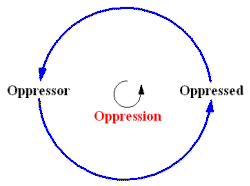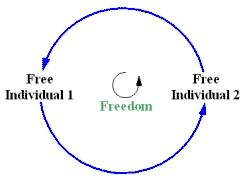The Free Market Center
The important structural differences between
liberty and oppression.
Many people place oppression and liberty on opposite ends of a continuum. They believe that as the amount of oppression diminishes the amount of liberty increases. Oppression and liberty, however, represent entirely different systemic structures. As a result, a person cannot move smoothly from a system of oppression to one of liberty.
I will explain the distinctions between oppression and liberty by using graphic representations of these two structures.
In a system of oppression both the oppressor and the oppressed gain something from their relationship. The oppressor gains by some form of unjust or cruel exercise of authority or power over the person or property of the oppressed. The oppressed also gain from this relationship. For example, an oppressor might tax the income or property of the oppressed, but in return the oppressed might receive the protection of the oppressor. Thus the system has a feedback relationship in which the structure of oppression is supported by both oppressor and the oppressed.

The Structure of Oppression
In spite of the feedback in a system of oppression this does not represent a balanced system. The oppressor gains more from the system than the oppressed. In the long-run this system amounts to a zero-sum game; one party always gets more of what he values than the other party in the system.
Because of the feedback in this structure, the system tends to become ever more burdensome for the oppressed. As a result, the oppressed will likely rise up and overthrow the oppressor. But this does not necessarily eliminate the structure of oppression and bring about a system of liberty. Generally the system of oppression continues. Only the roles of oppressed and oppressor become reversed.
Thus, what many people view as “liberty” simply consists of an oppressive structure in which their guys have the power. This becomes most insidious in any democratic system. In a democratic system the larger segment of the population oppresses the slightly smaller segment of the population. Therefore, people who advocate for limited government in reality advocate for limited oppression.
Before I describe the structure of liberty it might help to clarify the meaning of “freedom.”
Freedom consists of an inalienable element of the individual human nature. Freedom exists in both systems of oppression and liberty. People always have the freedom to do whatever they want within the limitations of the systemic structure in which they reside. The free person can violate, at will, the person or property of another person. He may suffer unpleasant consequences of such action, but that does not limit his freedom to act in such a manner.
When I say that freedom is limited by the systemic structure in which a person resides, that simply means that there might be some physical limitations to the person acting out their desires. E.g. a person cannot kill or steal from another when he is confined in some way that limits his access to the other person.
Unlike freedom, however, liberty does have limitations.
Liberty requires an entirely different structure.
It cannot exist in a structure of Oppression.
Liberty has a significantly different structure then does oppression. Quite simply, liberty consists of the voluntary interaction of naturally free individuals. As a result, unlike in oppression, within a system of liberty all parties to transactions gain as a result of these exchanges.

The Structure of Liberty
The structure of liberty, however, does place limitations on individual freedom. The actors within a structure of liberty voluntarily limit their freedom to behavior that does not violate the person or property of another person. No person in a system of liberty exercises any force or intervention on any other person or persons in the system.
A system of liberty excludes the existence of the government or nation-state, for they exercise violent intervention on members of the system. A system of liberty does not. It does not, however, exclude the existence of governance — i.e. voluntary agreements to regulate behavior. Exchanges between individuals in a system of liberty would include agreements as to the actions of the parties when they feel the agreement has been violated. They would choose at the outset a method for the resolution of any conflicts. Thus, all exchanges — and all parts of exchanges — would occur voluntarily.
I have simply mapped out the differences in the structure between oppression and liberty. Each of these structures has subtleties and nuances that I have not addressed here.
The main point that I wish to convey is that achieving liberty does not come simply from a reduction in oppression. Thus, liberation movements from outside the system, or secession movements from within the system, do not create real liberty. The members of a liberty system must join it voluntarily. If they have chosen to live in a structure of oppression, forcing them to leave that structure amounts to a form of oppression in itself. Also, if the liberation or secession creates a new form of government, that process has simply shifted from one system of oppression to another.
People who advocate for liberty need to understand these distinctions because achieving true liberty does not come easily. If one believes in limited government, he needs to be honest enough to admit that he believes in limited oppression and not liberty.
© 2010—2020 The Free Market Center & James B. Berger. All rights reserved.
To contact Jim Berger, e-mail: